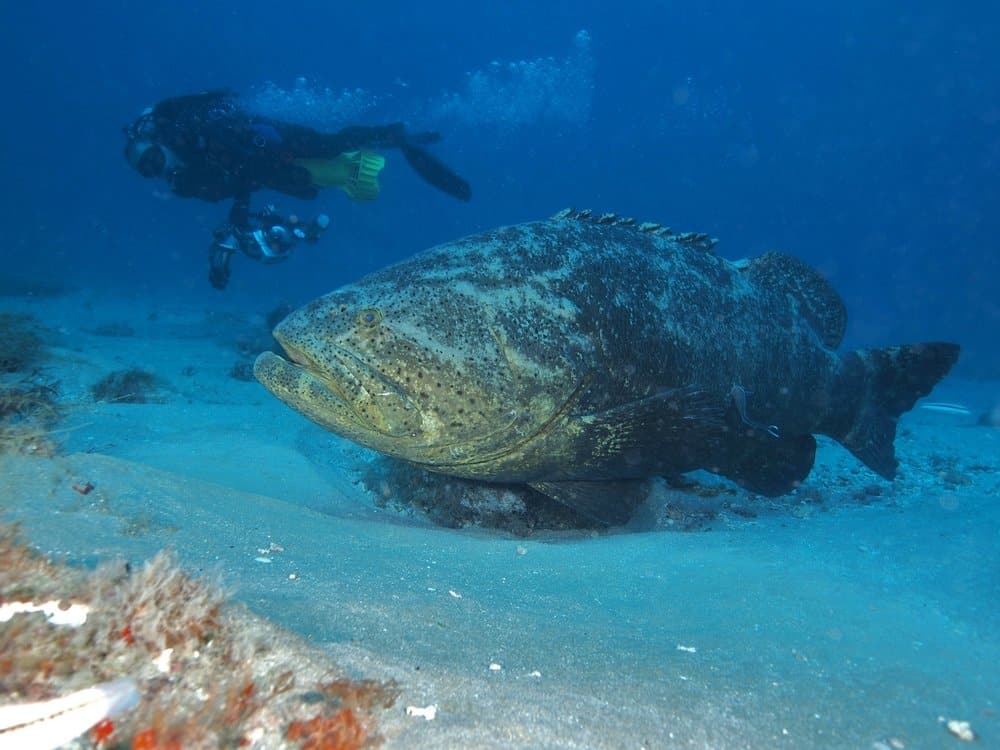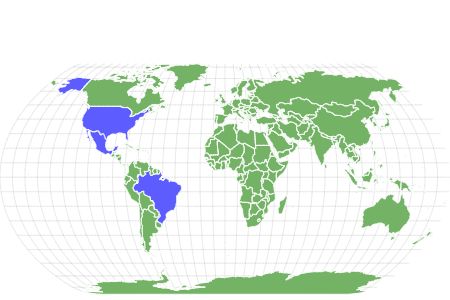Goliath Grouper
Epinephelus itajara
Goliath groupers are one of the largest reef fish in the world and they are quite inquisitive, so they are known to approach snorkelers and divers!
Advertisement
Goliath Grouper Scientific Classification
- Kingdom
- Animalia
- Phylum
- Chordata
- Class
- Actinopterygii
- Order
- Perciformes
- Family
- Scombridae
- Genus
- Epinephelinae
- Scientific Name
- Epinephelus itajara
Read our Complete Guide to Classification of Animals.
Goliath Grouper Conservation Status
Goliath Grouper Facts
- Prey
- crustaceans, small fish, snapper, eels
- Name Of Young
- goliath grouper juveniles
- Group Behavior
- Mainly solitary
- Fun Fact
- Goliath groupers are one of the largest reef fish in the world and they are quite inquisitive, so they are known to approach snorkelers and divers!
- Biggest Threat
- Overfishing
- Most Distinctive Feature
- Large mouth
- Other Name(s)
- Jewfish
View all of the Goliath Grouper images!
The goliath grouper is a huge saltwater fish that lives in tropical and subtropical waters worldwide.
Goliath Grouper Summary
The goliath grouper is a critically endangered large saltwater fish that lives in tropical and subtropical waters worldwide. They are typically brown or green in color, can grow up to 8 feet long, and weigh up to 800 pounds. Goliath groupers are apex predators, which means that they are at the very top of the food chain. They mainly eat smaller fish and crustaceans but have occasionally been found to even eat smaller sharks and turtles. Because of their size and power, goliath groupers are considered one of the most dangerous fish in the world. However, they are also timid and reclusive, so attacks on humans are rare unless the goliath grouper feels threatened.
5 Incredible Goliath Grouper Facts
- The goliath grouper is one of the largest reef fish in the world, reaching up to 8 feet in length and weighing up to 800 pounds.
- These massive fish are found in tropical waters worldwide, mainly along the coasts of Florida and Brazil.
- Goliath groupers are known for their docile nature and have been known to approach divers and even allow them to pet them on occasion.
- Despite their large size, these fish are shy and introverted and typically only come out to feed on smaller fish and crustaceans.
- Sadly, the goliath grouper is considered critically endangered due to overfishing and habitat loss by humans. However, laws now protect these fantastic creatures and help to ensure that their populations will one day rebound.
Goliath Grouper Scientific Name
The goliath grouper is a large saltwater fish found in tropical and subtropical waters worldwide, mainly in the Atlantic Ocean. The scientific name for the goliath grouper fish is Epinephelus itajara. The genus name for grouper, “epinephelus,” is a Greek word that translates to “cloudy”. The goliath grouper is also sometimes referred to as the jewfish. It was initially called the “jawfish” due to its massive mouth, but southern USA accents skewed the word into “jewfish”. However, this name is no longer used for the species because it is racially insensitive.
Goliath Grouper Appearance
As we know, the goliath grouper is a massive fish that can grow up to 8 feet long and weigh over 800 pounds. They have substantial, round bodies with wide mouths and small eyes.
Their coloring can vary quite a bit, but they are usually some shade of brown or green, with darker spots on their sides. This coloring helps the goliath grouper camouflage into its surroundings if needed. The goliath grouper has a short stubby tail, a tall spiky dorsal fin, and short pectoral fins.

Goliath groupers are considered one of the most dangerous fish in the world.
©Jonathan Churchill/Shutterstock.com
Goliath Grouper Evolution
Ichthyologists (fish scientists) believe the goliath grouper may have split into two similar grouper species some million years ago. The goliath grouper commonly found in the Atlantic Ocean appear very closely related to the species of grouper found in the Pacific Ocean. They are thought to have been the same animal at one point, and this split-off change is supposed to have occurred approximately 3 million years ago. That being said, today, the Atlantic grouper is much more impressive in size than the Pacific grouper.
Goliath Grouper Behavior
These fish are naturally inquisitive and often approach divers and snorkelers to check them out. While Goliath groupers are not considered dangerous to humans, they have been known to bite or attack if they feel threatened. They also have a powerful tail that can knock divers off balance. Therefore, respecting these fish and giving them space when you encounter them in the wild is crucial.
Goliath groupers are primarily solitary creatures, but they will congregate in large groups during the spawning season to breed. Spawning takes place between July and September; during this time, the fish will migrate to shallower waters where they can lay their eggs. After spawning, the goliath grouper will return to its solitary lifestyle until the next spawning season. During the rest of the year, these fish can be found hiding in caves, shipwrecks, or among coral reefs. They are ambush predators and will lie in wait for their prey before attacking.
Goliath Grouper Habitat
Goliath groupers are found in shallow tropical waters near shipwrecks, coral reefs, and rocky or muddy areas. They are most commonly found in the Western Atlantic Ocean from Florida to Brazil. However, they have also been found in the Eastern Atlantic Ocean, the Mediterranean, and the Gulf of Mexico. Groupers are generally bottom-dwelling fish, which means they spend most of their time near the ocean floor. They typically dwell between 100 to 200 feet below sea level.
Goliath Grouper Diet
Goliath groupers are opportunistic feeders and will consume a wide variety of smaller fish and invertebrates. They are not picky eaters, and their diet typically depends on what is most readily available to them in their environment. Smaller goliath groupers have been known to eat mainly crustaceans, while larger individuals tend to eat mostly fish. Some of the most common prey items for goliath groupers include snapper, grunts, moray eels, lobster, octopus, and squid.
While goliath groupers are not fussy about their meals, they do prefer live prey over dead or dying fish. This preference ensures that the food they are consuming is fresh and nutritious.
What Eats the Goliath Grouper?
Goliath groupers may be some of the largest reef-dwelling fish, but they are still subject to predation. Reef sharks, killer whales, and even other groupers can eat the slow-swimming goliath grouper. However, they are not the primary food source of many animals because they are challenging to catch and kill due to their strong and aggressive nature.
What Does the Goliath Grouper Eat?
The goliath grouper can eat a range of food but mainly eats crustaceans and small fish. If food is scarce, they will eat practically any animal in their environment, including other goliath groupers.
Goliath Grouper Predators and Threats
The goliath grouper is a vital part of the ecosystem, but several predators threaten them. Their main predators are sharks, barracudas, and other large fish. While goliath groupers will put up a fight, they are slow-moving fish, so these predators can catch and eat them.
Humans also threaten goliath groupers, as they are often caught for food or sport. Overfishing is a significant problem regarding the dangers of the goliath grouper. Thankfully, there are now some restrictions. But sadly, due to their isolating nature and slow mating habits, the population numbers still need time to recover.
Goliath Grouper Reproduction
The goliath grouper reproduces by a method known as “broadcast spawning”. The female goliath grouper releases the eggs into the water column while several male goliath groupers fertilize the eggs simultaneously.
Spawning for goliath groupers usually occurs in the summer months of where they are located and can even be influenced by the lunar cycle. Many grouper species are known to be hermaphrodites, meaning some can start life as females and turn into male groupers later in life. Goliath groupers are also believed to be hermaphrodites. However, this has not been studied closely by biologists.
Goliath Grouper Babies
After the eggs of the female goliath grouper are fertilized, they drift with the ocean current.
Once hatched, the larvae are said to appear kite-shaped and mature into juveniles within 25-26 days of hatching. The juveniles spend their early days hiding out in mangroves, away from the sight of predators.
Goliath Grouper Lifespan
Goliath grouper can live up to 50 years without predation or fishing threats, although most in the wild live to approximately 5-15 years of age due to these threats. They grow slowly, and are not afraid of humans. Their preferred habitat is rocky reefs close to the coast, which means they are at more risk of predators and overfishing. Human interference can affect their lifespan and put them at significant risk.
Some threats to the Goliath Grouper include, but are not limited to:
- Predators
- Slow breeding
- Parasites
- Humans
Goliath Grouper Population
The goliath grouper is currently considered critically endangered. Their slow growth rate, breeding cycles, and ease to capture mean they are at considerable risk of overfishing by fishermen. They continue to show a decline in population despite being a protected species. This means the goliath grouper is currently highly vulnerable to extinction.
In earlier days, the goliath grouper was extremely overfished in the United States, which brought them their current conservation status. Several things can be done to help protect goliath groupers and other fish populations from further decline. For example, people can support sustainable fishing practices and conservation efforts to protect fish habitats.
Goliath Grouper In Cooking
Prior to 1990, it was legal to catch and eat goliath groupers in the United States. But due to population decline, a ban was placed on harvesting and eating the species in 1990, in 1993 in the Caribbean, and in 2002 in Brazil. The meat was used in stews and soups and tasted very good. However, you will likely never try the fish because it is illegal to catch and kill one now. So, don’t go fishing for goliath grouper, and if you see it on a menu, report it for the sake of conservation!
Similar Animals
- Pacific Grouper: These fish are the close siblings of the goliath grouper. They were once the same species many moons ago, but they have split into Atlantic and Pacific groupers since.
- Bass: This is another critically endangered fish species. The bass is a predatory freshwater fish with a distinctly large mouth, much like the goliath grouper.
- Cod: Cod is an ocean fish that preys on smaller fish and crustaceans, a similar diet to that of the goliath grouper.
Goliath Grouper FAQs (Frequently Asked Questions)
Are goliath groupers carnivores, herbivores, or omnivores?
The goliath grouper is a carnivorous fish, as it eats other animals.
Is the goliath grouper monogamous?
The goliath grouper is not considered monogamous as they breed strictly through spawning.
Which continents is the goliath grouper found in?
The goliath grouper is usually found in the warmer waters of the Atlantic Ocean.
What is the average lifespan of a goliath grouper?
The average lifespan of goliath groupers in the wild is approximately 5-15 year. However, they can live up to 50 years in some cases.
Why is the goliath grouper endangered?
The goliath grouper is critically endangered due to the overfishing of the species that happened in the western Atlantic until around 1990. The species is still yet to recover from this.
Are goliath groupers aggressive?
While they do not typically attack swimmers and divers, you should keep your distance from these massive fish. They will defend their territory, and their bite can be harmful. They also have a muscular tail that can knock divers out!
Thank you for reading! Have some feedback for us? Contact the AZ Animals editorial team.
Sources
- Britannica, Available here: https://kids.britannica.com/students/article/goliath-grouper/327586
- Oceana.org, Available here: https://oceana.org/marine-life/atlantic-goliath-grouper/

















